Introduction to Business Report: Eagle Foods LTD Analysis
VerifiedAdded on 2020/11/12
|10
|3029
|170
Report
AI Summary
This report provides a detailed analysis of Eagle Foods LTD, a company specializing in milk-based products. It begins by outlining the functional areas of the business, including production, operations, customer service, marketing, accounting, research and development, and human resources. The report then explores the company's flat organizational structure, emphasizing its benefits for communication and decision-making. The importance of effective communication between leadership and management is examined, with examples of interdepartmental communication channels. Furthermore, the report delves into the current drivers of globalization, such as market, competitive, legal, technological, and cost drivers, and their impact on business operations. Finally, the report contrasts and compares different leadership styles, including authoritarian and transactional leadership, highlighting their advantages and disadvantages in various scenarios.

INTRODUCTION TO
BUSINESS
BUSINESS
Paraphrase This Document
Need a fresh take? Get an instant paraphrase of this document with our AI Paraphraser
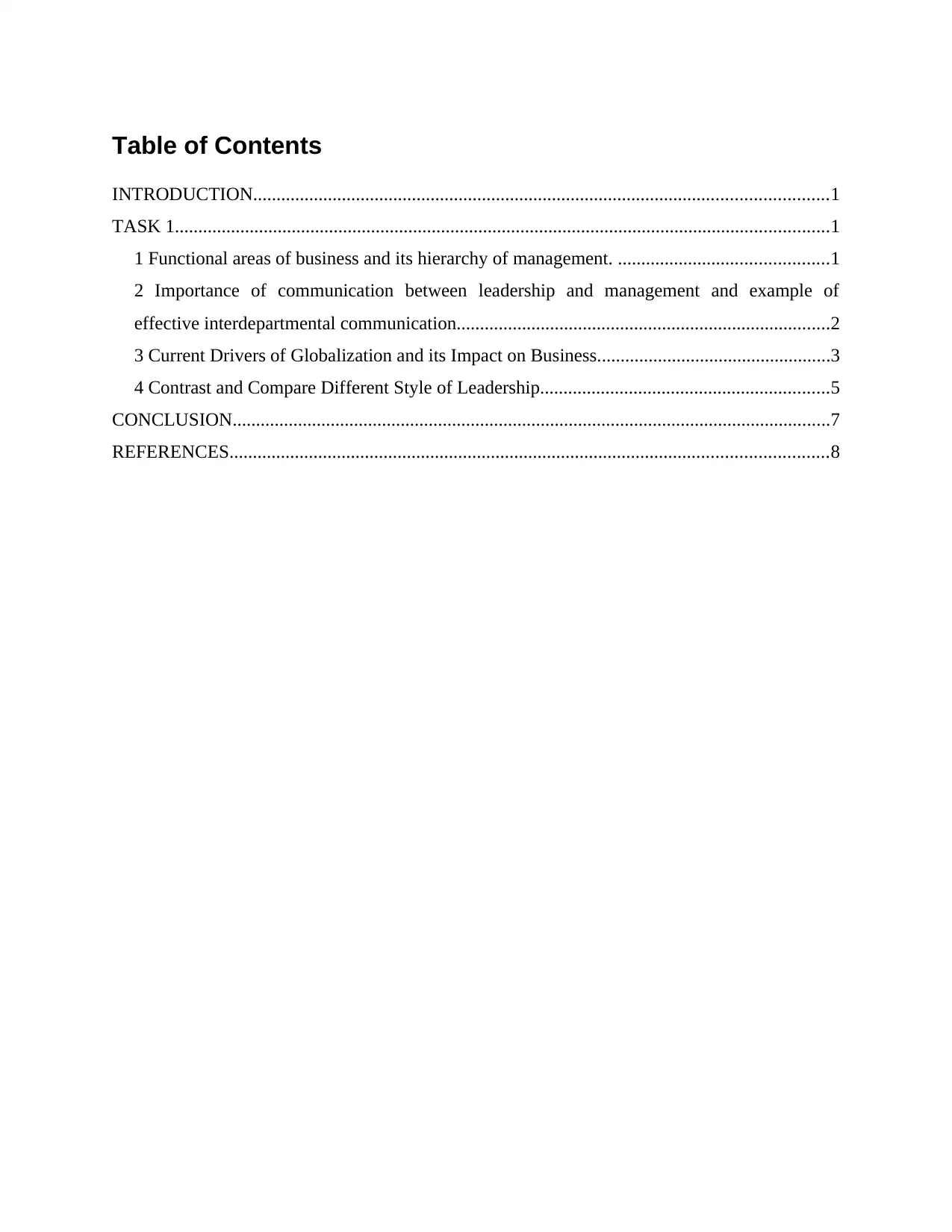
Table of Contents
INTRODUCTION...........................................................................................................................1
TASK 1............................................................................................................................................1
1 Functional areas of business and its hierarchy of management. .............................................1
2 Importance of communication between leadership and management and example of
effective interdepartmental communication................................................................................2
3 Current Drivers of Globalization and its Impact on Business..................................................3
4 Contrast and Compare Different Style of Leadership..............................................................5
CONCLUSION................................................................................................................................7
REFERENCES................................................................................................................................8
INTRODUCTION...........................................................................................................................1
TASK 1............................................................................................................................................1
1 Functional areas of business and its hierarchy of management. .............................................1
2 Importance of communication between leadership and management and example of
effective interdepartmental communication................................................................................2
3 Current Drivers of Globalization and its Impact on Business..................................................3
4 Contrast and Compare Different Style of Leadership..............................................................5
CONCLUSION................................................................................................................................7
REFERENCES................................................................................................................................8
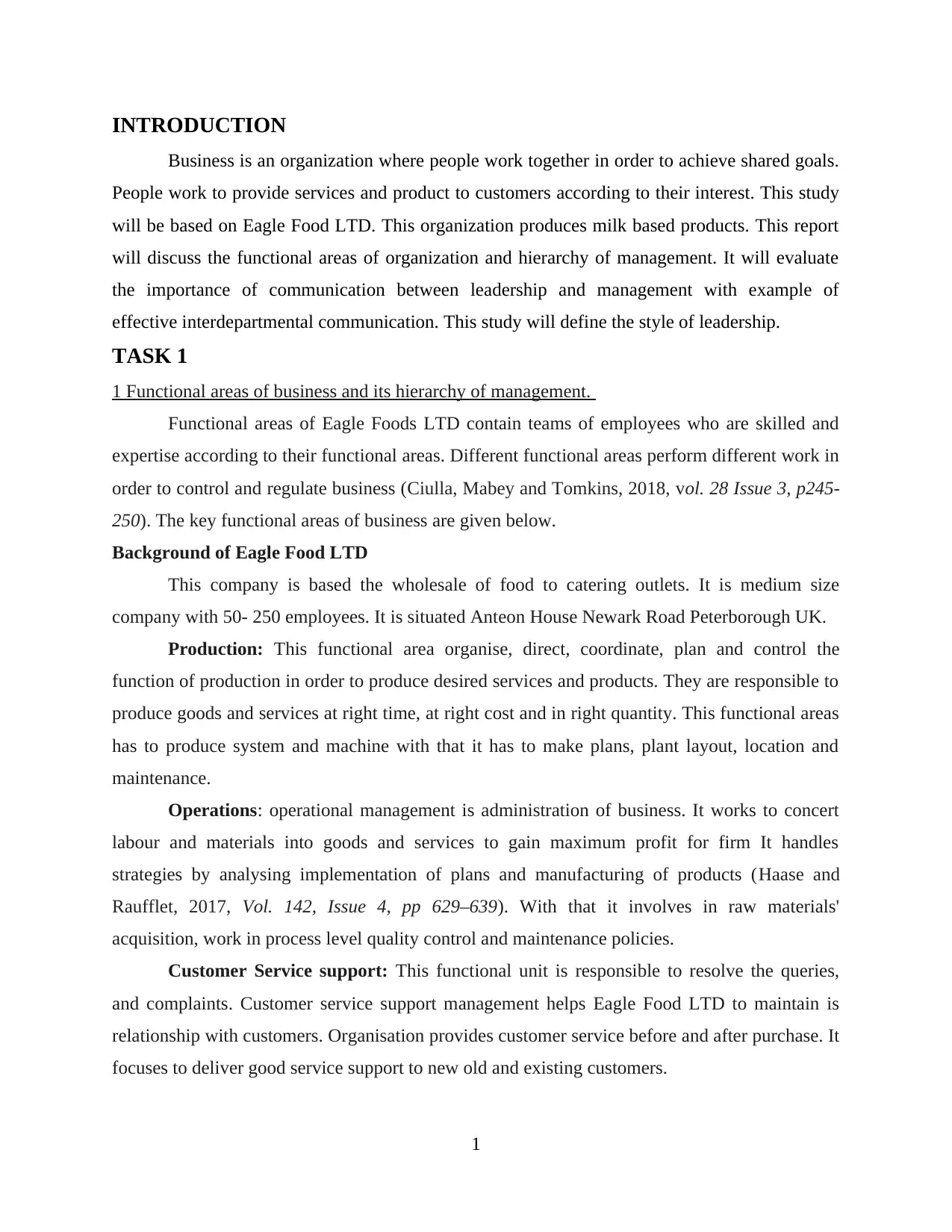
INTRODUCTION
Business is an organization where people work together in order to achieve shared goals.
People work to provide services and product to customers according to their interest. This study
will be based on Eagle Food LTD. This organization produces milk based products. This report
will discuss the functional areas of organization and hierarchy of management. It will evaluate
the importance of communication between leadership and management with example of
effective interdepartmental communication. This study will define the style of leadership.
TASK 1
1 Functional areas of business and its hierarchy of management.
Functional areas of Eagle Foods LTD contain teams of employees who are skilled and
expertise according to their functional areas. Different functional areas perform different work in
order to control and regulate business (Ciulla, Mabey and Tomkins, 2018, vol. 28 Issue 3, p245-
250). The key functional areas of business are given below.
Background of Eagle Food LTD
This company is based the wholesale of food to catering outlets. It is medium size
company with 50- 250 employees. It is situated Anteon House Newark Road Peterborough UK.
Production: This functional area organise, direct, coordinate, plan and control the
function of production in order to produce desired services and products. They are responsible to
produce goods and services at right time, at right cost and in right quantity. This functional areas
has to produce system and machine with that it has to make plans, plant layout, location and
maintenance.
Operations: operational management is administration of business. It works to concert
labour and materials into goods and services to gain maximum profit for firm It handles
strategies by analysing implementation of plans and manufacturing of products (Haase and
Raufflet, 2017, Vol. 142, Issue 4, pp 629–639). With that it involves in raw materials'
acquisition, work in process level quality control and maintenance policies.
Customer Service support: This functional unit is responsible to resolve the queries,
and complaints. Customer service support management helps Eagle Food LTD to maintain is
relationship with customers. Organisation provides customer service before and after purchase. It
focuses to deliver good service support to new old and existing customers.
1
Business is an organization where people work together in order to achieve shared goals.
People work to provide services and product to customers according to their interest. This study
will be based on Eagle Food LTD. This organization produces milk based products. This report
will discuss the functional areas of organization and hierarchy of management. It will evaluate
the importance of communication between leadership and management with example of
effective interdepartmental communication. This study will define the style of leadership.
TASK 1
1 Functional areas of business and its hierarchy of management.
Functional areas of Eagle Foods LTD contain teams of employees who are skilled and
expertise according to their functional areas. Different functional areas perform different work in
order to control and regulate business (Ciulla, Mabey and Tomkins, 2018, vol. 28 Issue 3, p245-
250). The key functional areas of business are given below.
Background of Eagle Food LTD
This company is based the wholesale of food to catering outlets. It is medium size
company with 50- 250 employees. It is situated Anteon House Newark Road Peterborough UK.
Production: This functional area organise, direct, coordinate, plan and control the
function of production in order to produce desired services and products. They are responsible to
produce goods and services at right time, at right cost and in right quantity. This functional areas
has to produce system and machine with that it has to make plans, plant layout, location and
maintenance.
Operations: operational management is administration of business. It works to concert
labour and materials into goods and services to gain maximum profit for firm It handles
strategies by analysing implementation of plans and manufacturing of products (Haase and
Raufflet, 2017, Vol. 142, Issue 4, pp 629–639). With that it involves in raw materials'
acquisition, work in process level quality control and maintenance policies.
Customer Service support: This functional unit is responsible to resolve the queries,
and complaints. Customer service support management helps Eagle Food LTD to maintain is
relationship with customers. Organisation provides customer service before and after purchase. It
focuses to deliver good service support to new old and existing customers.
1
⊘ This is a preview!⊘
Do you want full access?
Subscribe today to unlock all pages.

Trusted by 1+ million students worldwide
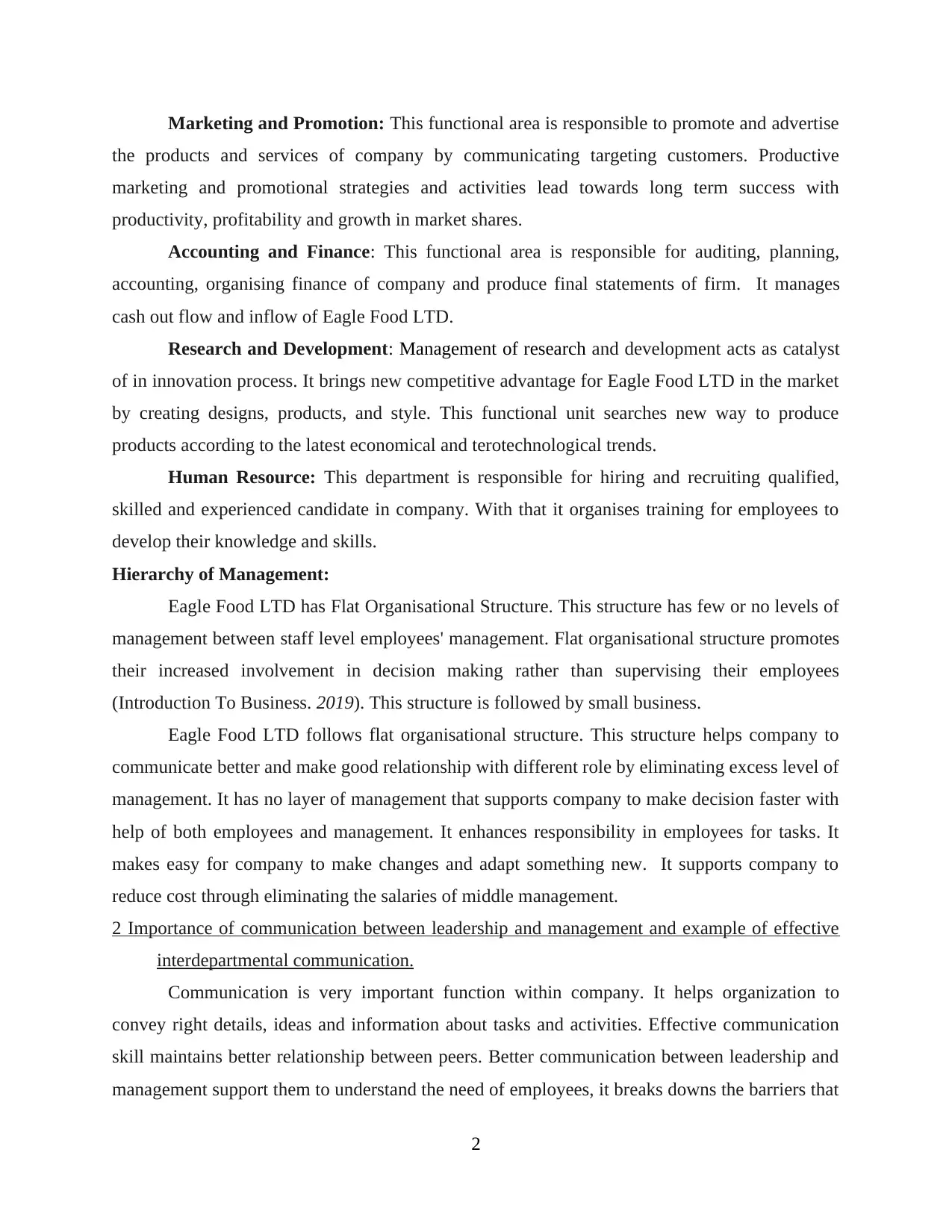
Marketing and Promotion: This functional area is responsible to promote and advertise
the products and services of company by communicating targeting customers. Productive
marketing and promotional strategies and activities lead towards long term success with
productivity, profitability and growth in market shares.
Accounting and Finance: This functional area is responsible for auditing, planning,
accounting, organising finance of company and produce final statements of firm. It manages
cash out flow and inflow of Eagle Food LTD.
Research and Development: Management of research and development acts as catalyst
of in innovation process. It brings new competitive advantage for Eagle Food LTD in the market
by creating designs, products, and style. This functional unit searches new way to produce
products according to the latest economical and terotechnological trends.
Human Resource: This department is responsible for hiring and recruiting qualified,
skilled and experienced candidate in company. With that it organises training for employees to
develop their knowledge and skills.
Hierarchy of Management:
Eagle Food LTD has Flat Organisational Structure. This structure has few or no levels of
management between staff level employees' management. Flat organisational structure promotes
their increased involvement in decision making rather than supervising their employees
(Introduction To Business. 2019). This structure is followed by small business.
Eagle Food LTD follows flat organisational structure. This structure helps company to
communicate better and make good relationship with different role by eliminating excess level of
management. It has no layer of management that supports company to make decision faster with
help of both employees and management. It enhances responsibility in employees for tasks. It
makes easy for company to make changes and adapt something new. It supports company to
reduce cost through eliminating the salaries of middle management.
2 Importance of communication between leadership and management and example of effective
interdepartmental communication.
Communication is very important function within company. It helps organization to
convey right details, ideas and information about tasks and activities. Effective communication
skill maintains better relationship between peers. Better communication between leadership and
management support them to understand the need of employees, it breaks downs the barriers that
2
the products and services of company by communicating targeting customers. Productive
marketing and promotional strategies and activities lead towards long term success with
productivity, profitability and growth in market shares.
Accounting and Finance: This functional area is responsible for auditing, planning,
accounting, organising finance of company and produce final statements of firm. It manages
cash out flow and inflow of Eagle Food LTD.
Research and Development: Management of research and development acts as catalyst
of in innovation process. It brings new competitive advantage for Eagle Food LTD in the market
by creating designs, products, and style. This functional unit searches new way to produce
products according to the latest economical and terotechnological trends.
Human Resource: This department is responsible for hiring and recruiting qualified,
skilled and experienced candidate in company. With that it organises training for employees to
develop their knowledge and skills.
Hierarchy of Management:
Eagle Food LTD has Flat Organisational Structure. This structure has few or no levels of
management between staff level employees' management. Flat organisational structure promotes
their increased involvement in decision making rather than supervising their employees
(Introduction To Business. 2019). This structure is followed by small business.
Eagle Food LTD follows flat organisational structure. This structure helps company to
communicate better and make good relationship with different role by eliminating excess level of
management. It has no layer of management that supports company to make decision faster with
help of both employees and management. It enhances responsibility in employees for tasks. It
makes easy for company to make changes and adapt something new. It supports company to
reduce cost through eliminating the salaries of middle management.
2 Importance of communication between leadership and management and example of effective
interdepartmental communication.
Communication is very important function within company. It helps organization to
convey right details, ideas and information about tasks and activities. Effective communication
skill maintains better relationship between peers. Better communication between leadership and
management support them to understand the need of employees, it breaks downs the barriers that
2
Paraphrase This Document
Need a fresh take? Get an instant paraphrase of this document with our AI Paraphraser
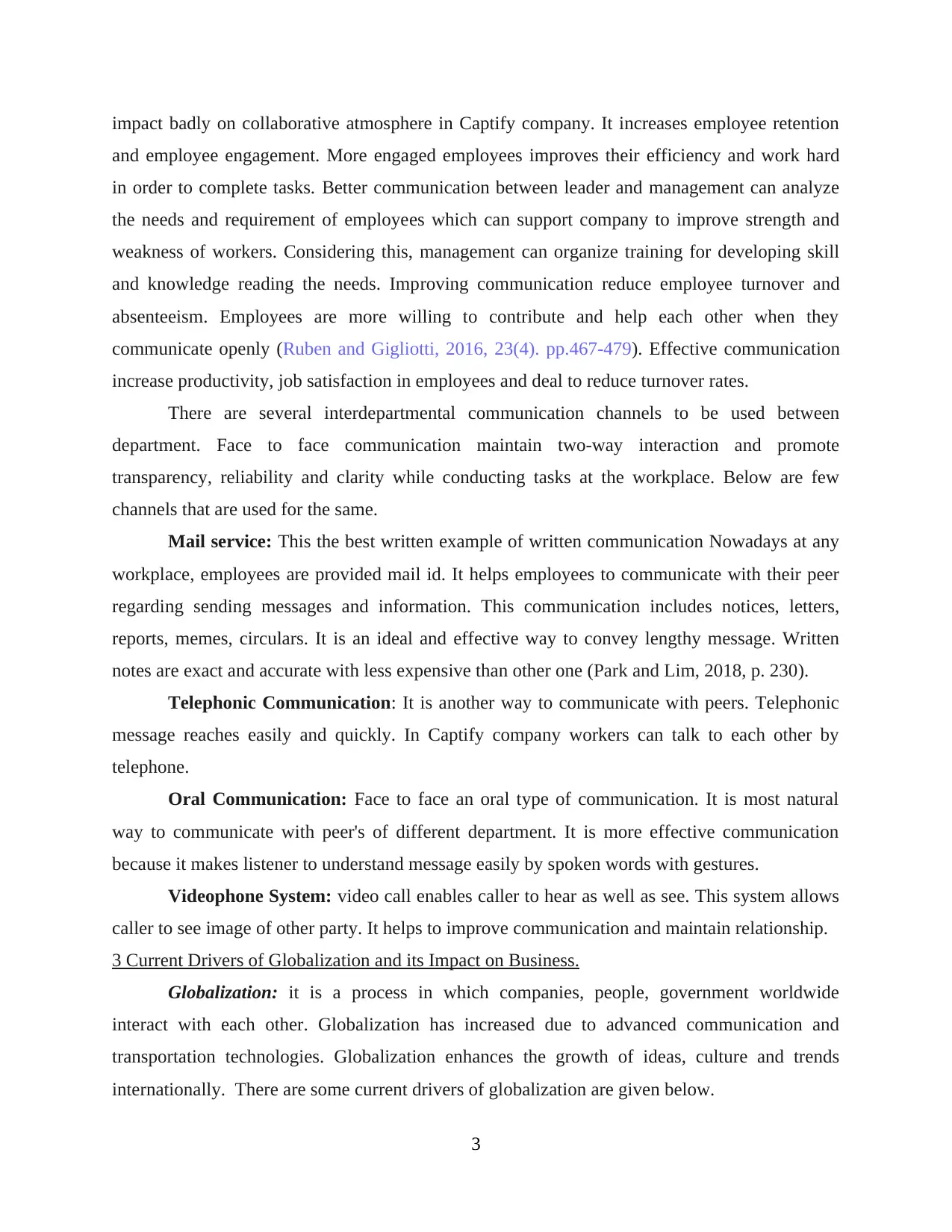
impact badly on collaborative atmosphere in Captify company. It increases employee retention
and employee engagement. More engaged employees improves their efficiency and work hard
in order to complete tasks. Better communication between leader and management can analyze
the needs and requirement of employees which can support company to improve strength and
weakness of workers. Considering this, management can organize training for developing skill
and knowledge reading the needs. Improving communication reduce employee turnover and
absenteeism. Employees are more willing to contribute and help each other when they
communicate openly (Ruben and Gigliotti, 2016, 23(4). pp.467-479). Effective communication
increase productivity, job satisfaction in employees and deal to reduce turnover rates.
There are several interdepartmental communication channels to be used between
department. Face to face communication maintain two-way interaction and promote
transparency, reliability and clarity while conducting tasks at the workplace. Below are few
channels that are used for the same.
Mail service: This the best written example of written communication Nowadays at any
workplace, employees are provided mail id. It helps employees to communicate with their peer
regarding sending messages and information. This communication includes notices, letters,
reports, memes, circulars. It is an ideal and effective way to convey lengthy message. Written
notes are exact and accurate with less expensive than other one (Park and Lim, 2018, p. 230).
Telephonic Communication: It is another way to communicate with peers. Telephonic
message reaches easily and quickly. In Captify company workers can talk to each other by
telephone.
Oral Communication: Face to face an oral type of communication. It is most natural
way to communicate with peer's of different department. It is more effective communication
because it makes listener to understand message easily by spoken words with gestures.
Videophone System: video call enables caller to hear as well as see. This system allows
caller to see image of other party. It helps to improve communication and maintain relationship.
3 Current Drivers of Globalization and its Impact on Business.
Globalization: it is a process in which companies, people, government worldwide
interact with each other. Globalization has increased due to advanced communication and
transportation technologies. Globalization enhances the growth of ideas, culture and trends
internationally. There are some current drivers of globalization are given below.
3
and employee engagement. More engaged employees improves their efficiency and work hard
in order to complete tasks. Better communication between leader and management can analyze
the needs and requirement of employees which can support company to improve strength and
weakness of workers. Considering this, management can organize training for developing skill
and knowledge reading the needs. Improving communication reduce employee turnover and
absenteeism. Employees are more willing to contribute and help each other when they
communicate openly (Ruben and Gigliotti, 2016, 23(4). pp.467-479). Effective communication
increase productivity, job satisfaction in employees and deal to reduce turnover rates.
There are several interdepartmental communication channels to be used between
department. Face to face communication maintain two-way interaction and promote
transparency, reliability and clarity while conducting tasks at the workplace. Below are few
channels that are used for the same.
Mail service: This the best written example of written communication Nowadays at any
workplace, employees are provided mail id. It helps employees to communicate with their peer
regarding sending messages and information. This communication includes notices, letters,
reports, memes, circulars. It is an ideal and effective way to convey lengthy message. Written
notes are exact and accurate with less expensive than other one (Park and Lim, 2018, p. 230).
Telephonic Communication: It is another way to communicate with peers. Telephonic
message reaches easily and quickly. In Captify company workers can talk to each other by
telephone.
Oral Communication: Face to face an oral type of communication. It is most natural
way to communicate with peer's of different department. It is more effective communication
because it makes listener to understand message easily by spoken words with gestures.
Videophone System: video call enables caller to hear as well as see. This system allows
caller to see image of other party. It helps to improve communication and maintain relationship.
3 Current Drivers of Globalization and its Impact on Business.
Globalization: it is a process in which companies, people, government worldwide
interact with each other. Globalization has increased due to advanced communication and
transportation technologies. Globalization enhances the growth of ideas, culture and trends
internationally. There are some current drivers of globalization are given below.
3
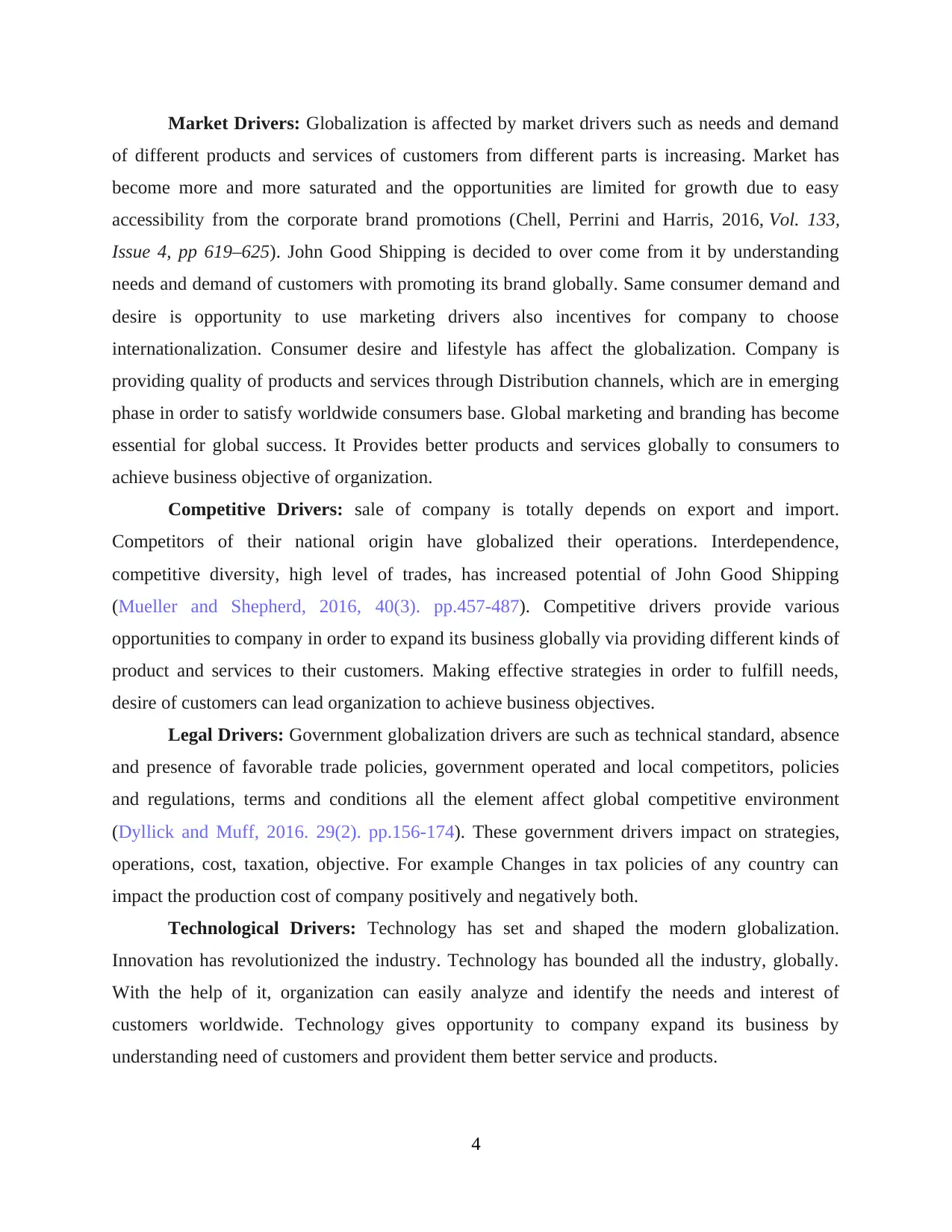
Market Drivers: Globalization is affected by market drivers such as needs and demand
of different products and services of customers from different parts is increasing. Market has
become more and more saturated and the opportunities are limited for growth due to easy
accessibility from the corporate brand promotions (Chell, Perrini and Harris, 2016, Vol. 133,
Issue 4, pp 619–625). John Good Shipping is decided to over come from it by understanding
needs and demand of customers with promoting its brand globally. Same consumer demand and
desire is opportunity to use marketing drivers also incentives for company to choose
internationalization. Consumer desire and lifestyle has affect the globalization. Company is
providing quality of products and services through Distribution channels, which are in emerging
phase in order to satisfy worldwide consumers base. Global marketing and branding has become
essential for global success. It Provides better products and services globally to consumers to
achieve business objective of organization.
Competitive Drivers: sale of company is totally depends on export and import.
Competitors of their national origin have globalized their operations. Interdependence,
competitive diversity, high level of trades, has increased potential of John Good Shipping
(Mueller and Shepherd, 2016, 40(3). pp.457-487). Competitive drivers provide various
opportunities to company in order to expand its business globally via providing different kinds of
product and services to their customers. Making effective strategies in order to fulfill needs,
desire of customers can lead organization to achieve business objectives.
Legal Drivers: Government globalization drivers are such as technical standard, absence
and presence of favorable trade policies, government operated and local competitors, policies
and regulations, terms and conditions all the element affect global competitive environment
(Dyllick and Muff, 2016. 29(2). pp.156-174). These government drivers impact on strategies,
operations, cost, taxation, objective. For example Changes in tax policies of any country can
impact the production cost of company positively and negatively both.
Technological Drivers: Technology has set and shaped the modern globalization.
Innovation has revolutionized the industry. Technology has bounded all the industry, globally.
With the help of it, organization can easily analyze and identify the needs and interest of
customers worldwide. Technology gives opportunity to company expand its business by
understanding need of customers and provident them better service and products.
4
of different products and services of customers from different parts is increasing. Market has
become more and more saturated and the opportunities are limited for growth due to easy
accessibility from the corporate brand promotions (Chell, Perrini and Harris, 2016, Vol. 133,
Issue 4, pp 619–625). John Good Shipping is decided to over come from it by understanding
needs and demand of customers with promoting its brand globally. Same consumer demand and
desire is opportunity to use marketing drivers also incentives for company to choose
internationalization. Consumer desire and lifestyle has affect the globalization. Company is
providing quality of products and services through Distribution channels, which are in emerging
phase in order to satisfy worldwide consumers base. Global marketing and branding has become
essential for global success. It Provides better products and services globally to consumers to
achieve business objective of organization.
Competitive Drivers: sale of company is totally depends on export and import.
Competitors of their national origin have globalized their operations. Interdependence,
competitive diversity, high level of trades, has increased potential of John Good Shipping
(Mueller and Shepherd, 2016, 40(3). pp.457-487). Competitive drivers provide various
opportunities to company in order to expand its business globally via providing different kinds of
product and services to their customers. Making effective strategies in order to fulfill needs,
desire of customers can lead organization to achieve business objectives.
Legal Drivers: Government globalization drivers are such as technical standard, absence
and presence of favorable trade policies, government operated and local competitors, policies
and regulations, terms and conditions all the element affect global competitive environment
(Dyllick and Muff, 2016. 29(2). pp.156-174). These government drivers impact on strategies,
operations, cost, taxation, objective. For example Changes in tax policies of any country can
impact the production cost of company positively and negatively both.
Technological Drivers: Technology has set and shaped the modern globalization.
Innovation has revolutionized the industry. Technology has bounded all the industry, globally.
With the help of it, organization can easily analyze and identify the needs and interest of
customers worldwide. Technology gives opportunity to company expand its business by
understanding need of customers and provident them better service and products.
4
⊘ This is a preview!⊘
Do you want full access?
Subscribe today to unlock all pages.

Trusted by 1+ million students worldwide
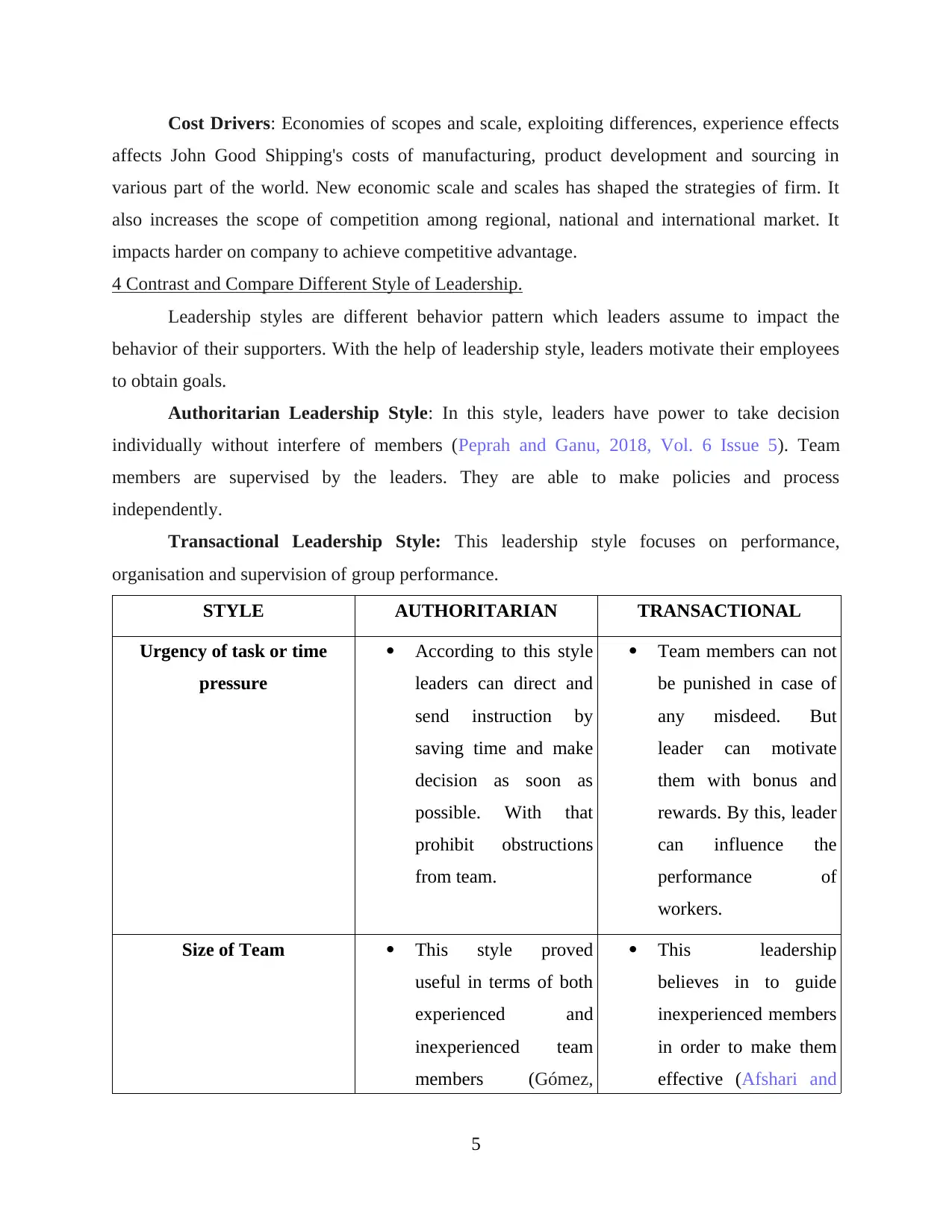
Cost Drivers: Economies of scopes and scale, exploiting differences, experience effects
affects John Good Shipping's costs of manufacturing, product development and sourcing in
various part of the world. New economic scale and scales has shaped the strategies of firm. It
also increases the scope of competition among regional, national and international market. It
impacts harder on company to achieve competitive advantage.
4 Contrast and Compare Different Style of Leadership.
Leadership styles are different behavior pattern which leaders assume to impact the
behavior of their supporters. With the help of leadership style, leaders motivate their employees
to obtain goals.
Authoritarian Leadership Style: In this style, leaders have power to take decision
individually without interfere of members (Peprah and Ganu, 2018, Vol. 6 Issue 5). Team
members are supervised by the leaders. They are able to make policies and process
independently.
Transactional Leadership Style: This leadership style focuses on performance,
organisation and supervision of group performance.
STYLE AUTHORITARIAN TRANSACTIONAL
Urgency of task or time
pressure
According to this style
leaders can direct and
send instruction by
saving time and make
decision as soon as
possible. With that
prohibit obstructions
from team.
Team members can not
be punished in case of
any misdeed. But
leader can motivate
them with bonus and
rewards. By this, leader
can influence the
performance of
workers.
Size of Team This style proved
useful in terms of both
experienced and
inexperienced team
members (Gómez,
This leadership
believes in to guide
inexperienced members
in order to make them
effective (Afshari and
5
affects John Good Shipping's costs of manufacturing, product development and sourcing in
various part of the world. New economic scale and scales has shaped the strategies of firm. It
also increases the scope of competition among regional, national and international market. It
impacts harder on company to achieve competitive advantage.
4 Contrast and Compare Different Style of Leadership.
Leadership styles are different behavior pattern which leaders assume to impact the
behavior of their supporters. With the help of leadership style, leaders motivate their employees
to obtain goals.
Authoritarian Leadership Style: In this style, leaders have power to take decision
individually without interfere of members (Peprah and Ganu, 2018, Vol. 6 Issue 5). Team
members are supervised by the leaders. They are able to make policies and process
independently.
Transactional Leadership Style: This leadership style focuses on performance,
organisation and supervision of group performance.
STYLE AUTHORITARIAN TRANSACTIONAL
Urgency of task or time
pressure
According to this style
leaders can direct and
send instruction by
saving time and make
decision as soon as
possible. With that
prohibit obstructions
from team.
Team members can not
be punished in case of
any misdeed. But
leader can motivate
them with bonus and
rewards. By this, leader
can influence the
performance of
workers.
Size of Team This style proved
useful in terms of both
experienced and
inexperienced team
members (Gómez,
This leadership
believes in to guide
inexperienced members
in order to make them
effective (Afshari and
5
Paraphrase This Document
Need a fresh take? Get an instant paraphrase of this document with our AI Paraphraser
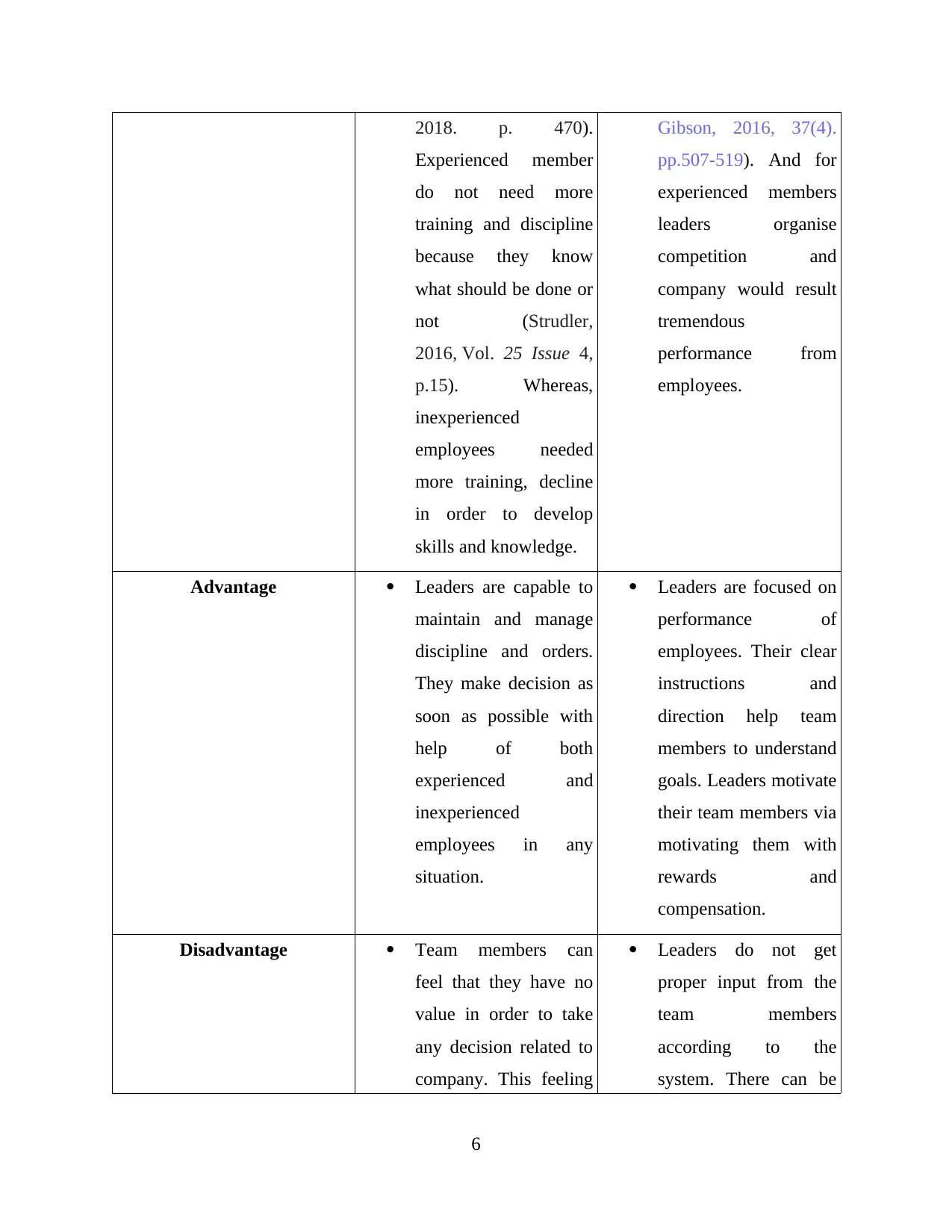
2018. p. 470).
Experienced member
do not need more
training and discipline
because they know
what should be done or
not (Strudler,
2016, Vol. 25 Issue 4,
p.15). Whereas,
inexperienced
employees needed
more training, decline
in order to develop
skills and knowledge.
Gibson, 2016, 37(4).
pp.507-519). And for
experienced members
leaders organise
competition and
company would result
tremendous
performance from
employees.
Advantage Leaders are capable to
maintain and manage
discipline and orders.
They make decision as
soon as possible with
help of both
experienced and
inexperienced
employees in any
situation.
Leaders are focused on
performance of
employees. Their clear
instructions and
direction help team
members to understand
goals. Leaders motivate
their team members via
motivating them with
rewards and
compensation.
Disadvantage Team members can
feel that they have no
value in order to take
any decision related to
company. This feeling
Leaders do not get
proper input from the
team members
according to the
system. There can be
6
Experienced member
do not need more
training and discipline
because they know
what should be done or
not (Strudler,
2016, Vol. 25 Issue 4,
p.15). Whereas,
inexperienced
employees needed
more training, decline
in order to develop
skills and knowledge.
Gibson, 2016, 37(4).
pp.507-519). And for
experienced members
leaders organise
competition and
company would result
tremendous
performance from
employees.
Advantage Leaders are capable to
maintain and manage
discipline and orders.
They make decision as
soon as possible with
help of both
experienced and
inexperienced
employees in any
situation.
Leaders are focused on
performance of
employees. Their clear
instructions and
direction help team
members to understand
goals. Leaders motivate
their team members via
motivating them with
rewards and
compensation.
Disadvantage Team members can
feel that they have no
value in order to take
any decision related to
company. This feeling
Leaders do not get
proper input from the
team members
according to the
system. There can be
6
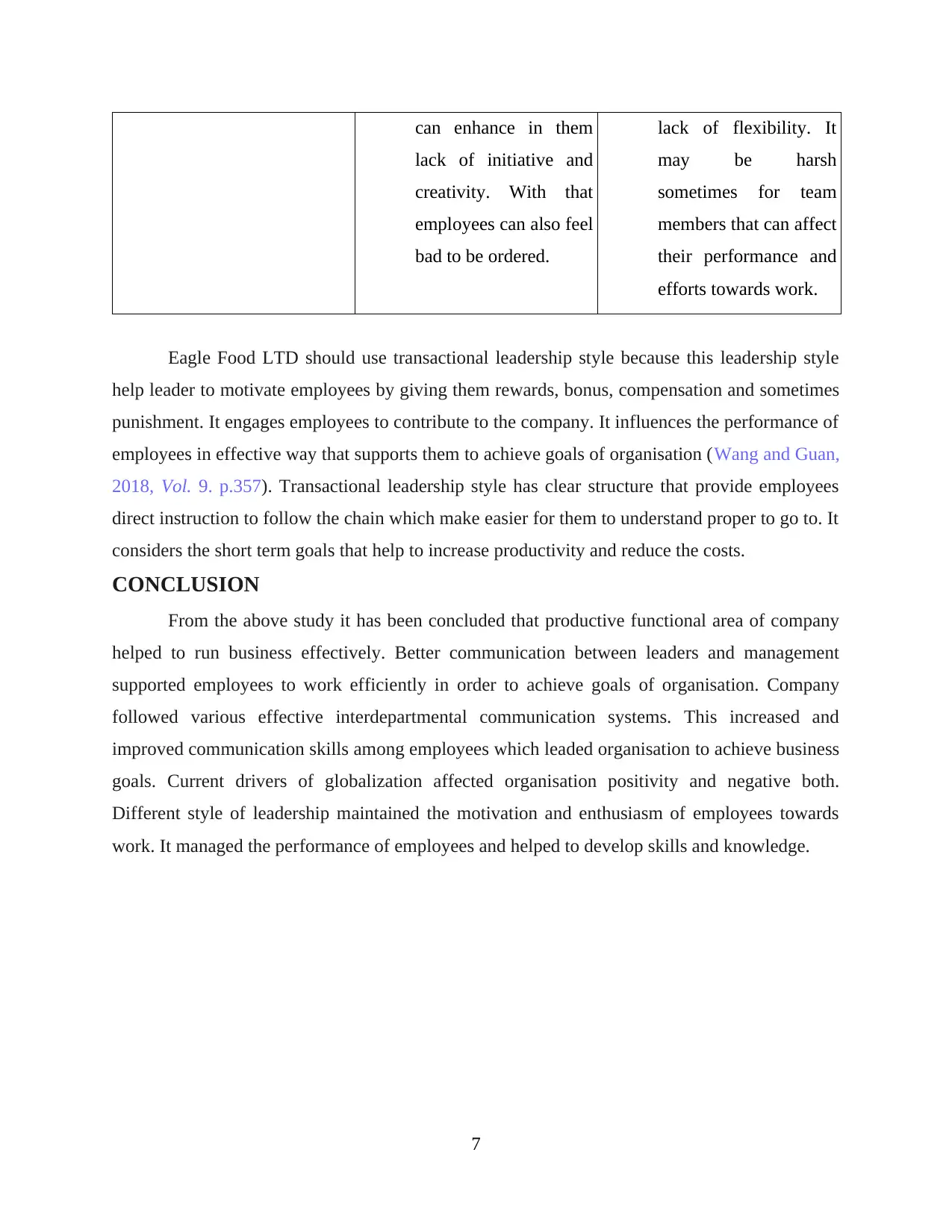
can enhance in them
lack of initiative and
creativity. With that
employees can also feel
bad to be ordered.
lack of flexibility. It
may be harsh
sometimes for team
members that can affect
their performance and
efforts towards work.
Eagle Food LTD should use transactional leadership style because this leadership style
help leader to motivate employees by giving them rewards, bonus, compensation and sometimes
punishment. It engages employees to contribute to the company. It influences the performance of
employees in effective way that supports them to achieve goals of organisation (Wang and Guan,
2018, Vol. 9. p.357). Transactional leadership style has clear structure that provide employees
direct instruction to follow the chain which make easier for them to understand proper to go to. It
considers the short term goals that help to increase productivity and reduce the costs.
CONCLUSION
From the above study it has been concluded that productive functional area of company
helped to run business effectively. Better communication between leaders and management
supported employees to work efficiently in order to achieve goals of organisation. Company
followed various effective interdepartmental communication systems. This increased and
improved communication skills among employees which leaded organisation to achieve business
goals. Current drivers of globalization affected organisation positivity and negative both.
Different style of leadership maintained the motivation and enthusiasm of employees towards
work. It managed the performance of employees and helped to develop skills and knowledge.
7
lack of initiative and
creativity. With that
employees can also feel
bad to be ordered.
lack of flexibility. It
may be harsh
sometimes for team
members that can affect
their performance and
efforts towards work.
Eagle Food LTD should use transactional leadership style because this leadership style
help leader to motivate employees by giving them rewards, bonus, compensation and sometimes
punishment. It engages employees to contribute to the company. It influences the performance of
employees in effective way that supports them to achieve goals of organisation (Wang and Guan,
2018, Vol. 9. p.357). Transactional leadership style has clear structure that provide employees
direct instruction to follow the chain which make easier for them to understand proper to go to. It
considers the short term goals that help to increase productivity and reduce the costs.
CONCLUSION
From the above study it has been concluded that productive functional area of company
helped to run business effectively. Better communication between leaders and management
supported employees to work efficiently in order to achieve goals of organisation. Company
followed various effective interdepartmental communication systems. This increased and
improved communication skills among employees which leaded organisation to achieve business
goals. Current drivers of globalization affected organisation positivity and negative both.
Different style of leadership maintained the motivation and enthusiasm of employees towards
work. It managed the performance of employees and helped to develop skills and knowledge.
7
⊘ This is a preview!⊘
Do you want full access?
Subscribe today to unlock all pages.

Trusted by 1+ million students worldwide
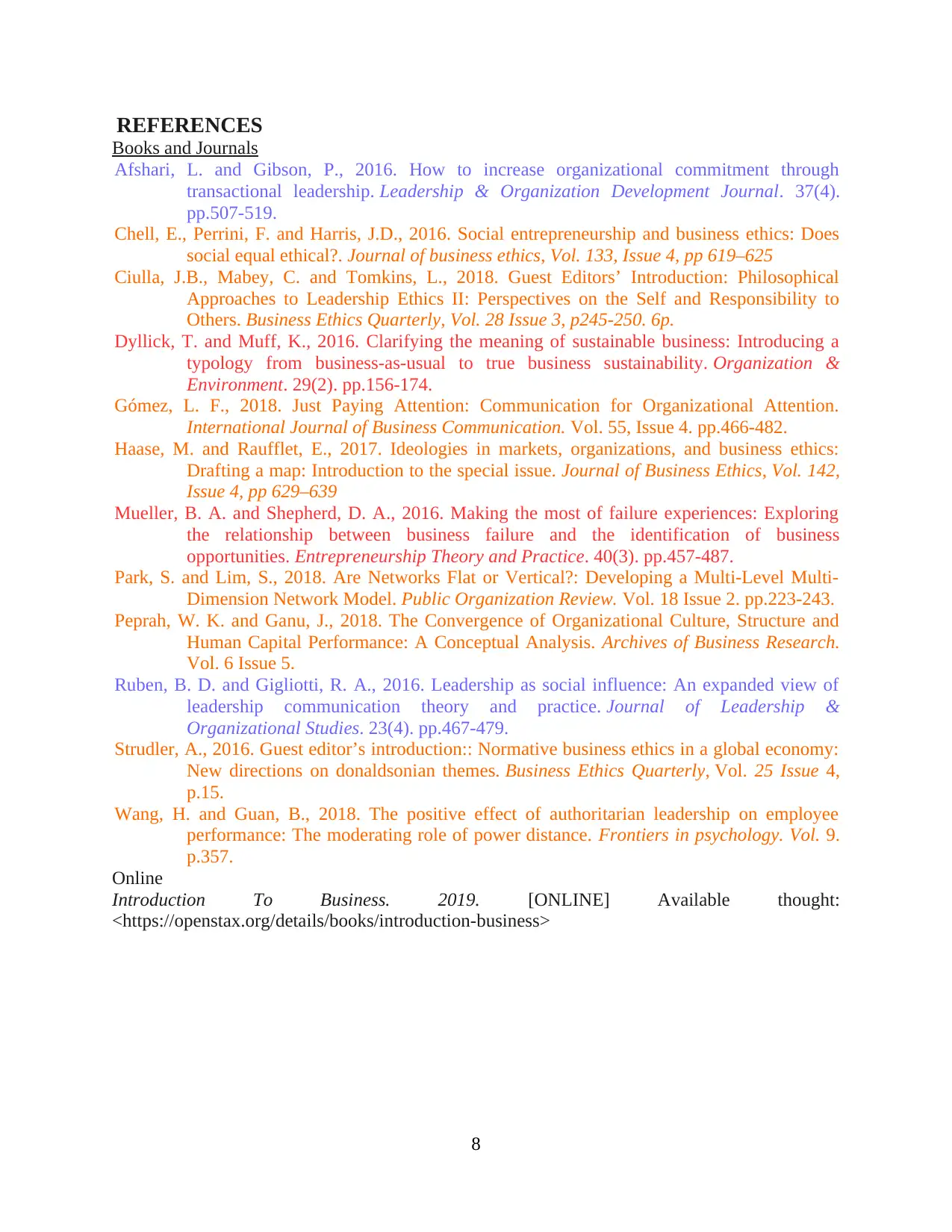
REFERENCES
Books and Journals
Afshari, L. and Gibson, P., 2016. How to increase organizational commitment through
transactional leadership. Leadership & Organization Development Journal. 37(4).
pp.507-519.
Chell, E., Perrini, F. and Harris, J.D., 2016. Social entrepreneurship and business ethics: Does
social equal ethical?. Journal of business ethics, Vol. 133, Issue 4, pp 619–625
Ciulla, J.B., Mabey, C. and Tomkins, L., 2018. Guest Editors’ Introduction: Philosophical
Approaches to Leadership Ethics II: Perspectives on the Self and Responsibility to
Others. Business Ethics Quarterly, Vol. 28 Issue 3, p245-250. 6p.
Dyllick, T. and Muff, K., 2016. Clarifying the meaning of sustainable business: Introducing a
typology from business-as-usual to true business sustainability. Organization &
Environment. 29(2). pp.156-174.
Gómez, L. F., 2018. Just Paying Attention: Communication for Organizational Attention.
International Journal of Business Communication. Vol. 55, Issue 4. pp.466-482.
Haase, M. and Raufflet, E., 2017. Ideologies in markets, organizations, and business ethics:
Drafting a map: Introduction to the special issue. Journal of Business Ethics, Vol. 142,
Issue 4, pp 629–639
Mueller, B. A. and Shepherd, D. A., 2016. Making the most of failure experiences: Exploring
the relationship between business failure and the identification of business
opportunities. Entrepreneurship Theory and Practice. 40(3). pp.457-487.
Park, S. and Lim, S., 2018. Are Networks Flat or Vertical?: Developing a Multi-Level Multi-
Dimension Network Model. Public Organization Review. Vol. 18 Issue 2. pp.223-243.
Peprah, W. K. and Ganu, J., 2018. The Convergence of Organizational Culture, Structure and
Human Capital Performance: A Conceptual Analysis. Archives of Business Research.
Vol. 6 Issue 5.
Ruben, B. D. and Gigliotti, R. A., 2016. Leadership as social influence: An expanded view of
leadership communication theory and practice. Journal of Leadership &
Organizational Studies. 23(4). pp.467-479.
Strudler, A., 2016. Guest editor’s introduction:: Normative business ethics in a global economy:
New directions on donaldsonian themes. Business Ethics Quarterly, Vol. 25 Issue 4,
p.15.
Wang, H. and Guan, B., 2018. The positive effect of authoritarian leadership on employee
performance: The moderating role of power distance. Frontiers in psychology. Vol. 9.
p.357.
Online
Introduction To Business. 2019. [ONLINE] Available thought:
<https://openstax.org/details/books/introduction-business>
8
Books and Journals
Afshari, L. and Gibson, P., 2016. How to increase organizational commitment through
transactional leadership. Leadership & Organization Development Journal. 37(4).
pp.507-519.
Chell, E., Perrini, F. and Harris, J.D., 2016. Social entrepreneurship and business ethics: Does
social equal ethical?. Journal of business ethics, Vol. 133, Issue 4, pp 619–625
Ciulla, J.B., Mabey, C. and Tomkins, L., 2018. Guest Editors’ Introduction: Philosophical
Approaches to Leadership Ethics II: Perspectives on the Self and Responsibility to
Others. Business Ethics Quarterly, Vol. 28 Issue 3, p245-250. 6p.
Dyllick, T. and Muff, K., 2016. Clarifying the meaning of sustainable business: Introducing a
typology from business-as-usual to true business sustainability. Organization &
Environment. 29(2). pp.156-174.
Gómez, L. F., 2018. Just Paying Attention: Communication for Organizational Attention.
International Journal of Business Communication. Vol. 55, Issue 4. pp.466-482.
Haase, M. and Raufflet, E., 2017. Ideologies in markets, organizations, and business ethics:
Drafting a map: Introduction to the special issue. Journal of Business Ethics, Vol. 142,
Issue 4, pp 629–639
Mueller, B. A. and Shepherd, D. A., 2016. Making the most of failure experiences: Exploring
the relationship between business failure and the identification of business
opportunities. Entrepreneurship Theory and Practice. 40(3). pp.457-487.
Park, S. and Lim, S., 2018. Are Networks Flat or Vertical?: Developing a Multi-Level Multi-
Dimension Network Model. Public Organization Review. Vol. 18 Issue 2. pp.223-243.
Peprah, W. K. and Ganu, J., 2018. The Convergence of Organizational Culture, Structure and
Human Capital Performance: A Conceptual Analysis. Archives of Business Research.
Vol. 6 Issue 5.
Ruben, B. D. and Gigliotti, R. A., 2016. Leadership as social influence: An expanded view of
leadership communication theory and practice. Journal of Leadership &
Organizational Studies. 23(4). pp.467-479.
Strudler, A., 2016. Guest editor’s introduction:: Normative business ethics in a global economy:
New directions on donaldsonian themes. Business Ethics Quarterly, Vol. 25 Issue 4,
p.15.
Wang, H. and Guan, B., 2018. The positive effect of authoritarian leadership on employee
performance: The moderating role of power distance. Frontiers in psychology. Vol. 9.
p.357.
Online
Introduction To Business. 2019. [ONLINE] Available thought:
<https://openstax.org/details/books/introduction-business>
8
1 out of 10
Related Documents
Your All-in-One AI-Powered Toolkit for Academic Success.
+13062052269
info@desklib.com
Available 24*7 on WhatsApp / Email
![[object Object]](/_next/static/media/star-bottom.7253800d.svg)
Unlock your academic potential
Copyright © 2020–2025 A2Z Services. All Rights Reserved. Developed and managed by ZUCOL.


